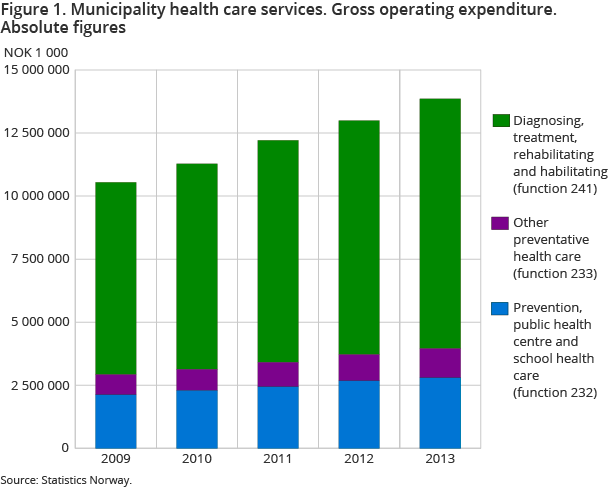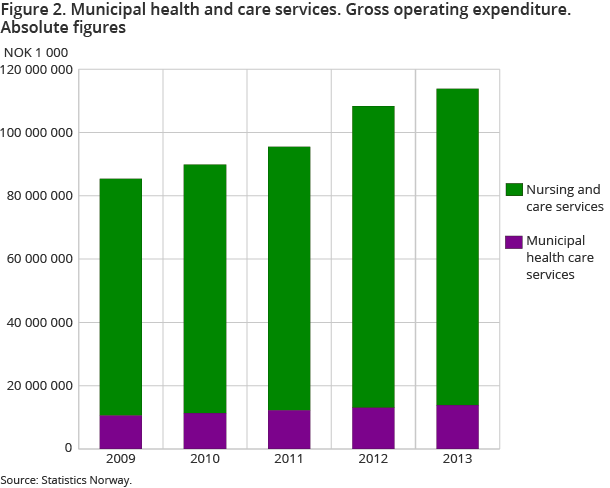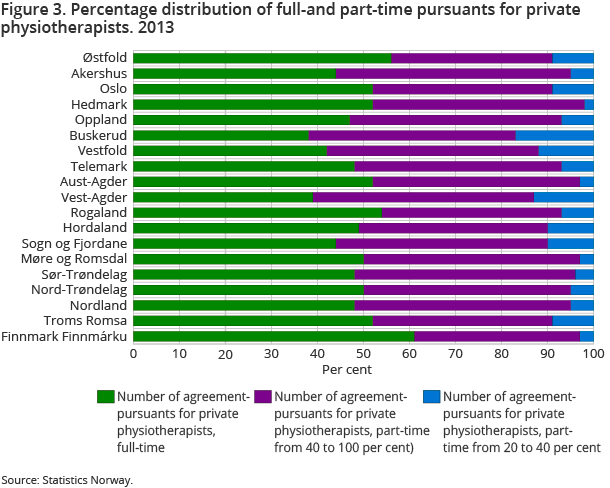Content
Published:
This is an archived release.
Almost NOK 14 billion on municipal health care services
In 2013, roughly NOK 14 billion was spent on municipal health care services, which is a 6.6 per cent growth since 2012. As for previous years, the largest share of spending is related to diagnostics, treatment, rehabilitation and habilitation in the municipalities.
| 2013 | 2013 | 2012 - 2013 | 2009 - 2013 | |
|---|---|---|---|---|
| Absolute figures | Per 10 000 inhabitants | Percentage change1 | Percentage change1 | |
| 1Percentage change is based on absolute figures | ||||
| Man-years for physicians in the municipal health service | 5 196.8 | 10.2 | 3.5 | 12.1 |
| Man-years for physiotherapists | 4 535.4 | 8.9 | 2.4 | 7.5 |
| Absolute figures | Per inhabitant | Percentage change1 | Percentage change1 | |
| Gross operating expenditure municipal health in total (1 000 NOK) | 13 851 363 | 2 711.1 | 6.6 | 31.3 |
| Gross operating expenditure. Preventive health (enviormental health care) (1 000 NOK) | 1 153 939 | 225.9 | 10.7 | 43.1 |
| Gross operating expenditure. Diagnosis, treatment and rehabilitation, function 241, (1 000 NOK) | 9 903 486 | 1 938.4 | 6.8 | 29.8 |
| Absolute figures | Per 10 000 inhabitants 0-20 years | Percentage change1 | Percentage change1 | |
| Gross operating expenditure. Preventive health (enviormental health care) (1 000 NOK) | 2 793 938 | 2 112.3 | 4.4 | 32.1 |
| Man-years health centers and school health | 4 217.2 | 31.9 | -1.4 | .. |



Measured by gross operating expenditure, the expenses related to municipal health care services have risen steadily over time, and the increase continued from 2012 to 2013. In 2013, the gross operating expenditure totalled NOK 13.9 billion; an increase by 6.6 per cent since 2012 and 31.3 per cent since 2009. The largest amount of expenditure is related to diagnostics, treatment, rehabilitation and habilitation. Among other things, this includes basic grants for general practitioners, municipal casualty wards and physiotherapy. In 2013, the expenditure for these purposes was almost NOK 10 billion, which represents an increase of 6.8 per cent since 2012.
Furthermore, in 2013, the expenditure related to prevention in the form of services provided by public health centres and school health care was about NOK 2.8 billion; an increase of 4.4 per cent since 2012. The amount includes spending on public health centres for children and adolescents, school health care in primary, lower secondary and upper secondary schools, and midwife services. The expenditure related to other preventive health services in the municipalities, for instance public health centres for the elderly and immigrants respectively, amounted to NOK 1.2 billion in 2013; an increase of 10.7 per cent since 2012.
Total expenditure related to municipal health and care services
The Coordination Reform that was implemented on 1 January 2012 in the Norwegian health service resulted in both organisational and financial changes in the services. Municipal health care services on the one hand and nursing and care services in the municipalities on the other should be viewed together as a consequence of the fact that these two constitute what is referred to as municipal health and care services in the legislation (kommunale helse- og omsorgstenester).
The expenditure related to municipal health and care services in total, which includes both municipal health care services and nursing and care services in the municipalities, amounted to about NOK 114 billion in 2013; an increase of 5 per cent since 2012. Some of the expenditure is related to economic policy instruments of the Coordination Reform and has at least some influence on the level of expenses. Municipal co-financing of specialist health care services is one of three economic policy instruments directly related to the reform, and amounted to NOK 5.3 billion in 2013; an increase of 2.6 per cent since 2012. However, it should be noted that this policy instrument will be discontinued in 2015 due to decisions made by the government.
The municipal expenditure related to emergency services; another economic policy instrument related to the Coordination Reform, totalled NOK 208 million in 2013. This represents a much higher level of expenses than the roughly NOK 40 million in 2012, and there is reason to believe that the expenses will increase further by the time this service is a statutory task for the municipalities from 1 January 2016.
The municipal responsibility for patients ready for discharge from hospitals in the specialist health care services is a third economic policy instrument associated with the reform. Even though this responsibility has played its part when it comes to expenses in the municipalities, it is almost impossible to identify the exact level of expenses in municipality accounts. Nevertheless, these expenses belong under the more collective term “municipal health and care services in institutions”, which amount to NOK 39.3 billion in 2013.
Increased number of agreements between municipalities and GPs
The number of agreements made between municipalities and general practitioners (GPs) and the number of open patient lists (capacity to include more patients) within the patient list system have both increased from 2012 to 2013. The number of agreements increased by 2.5 per cent from 4 298 in 2012 to 4 407 in 2013, while the number of open patient lists has increased by 6.8 per cent from 1 719 to 1 836 in the same period. Moreover, the number of patient lists without a regular GP and the number of patients registered on such patient lists decreased from 2012 to 2013. In summary, these indicators could imply that the supply of regular GPs is strengthened at the national level.
The agreements made between municipalities and GPs regulate to what extent the regular GP provides services other than tasks directly associated with patient treatment. Among other things, this includes services produced at public health centres and school health care, and other preventive health services in the municipalities. The tendency from previous years of a reduction in the number of hours the regular GPs spend on this kind of work is continued from 2012 to 2013. In 2013, the regular general practitioners spent almost 304 man-years on this work, which is a decline of 3 per cent (8 man-years) since 2012 and 15 per cent (52 man-years) since 2009.
Same share of female regular GPs who are immigrants as for other GPs
At the end of 2013, a total of 4 386 persons were practising as a regular GP in Norwegian municipalities. Twenty-one per cent of these are immigrants. About half of the GPs who are immigrants come from EU and EEA countries. The country with the highest number of regular GPs who are immigrants is Germany, with 125 persons, followed by Denmark with 111 persons.
Both among regular GPs who are immigrants and other GPs, two out of five are women. While 42 per cent of female regular GPs who are immigrants come from the EU and EEA except the Nordic countries, the corresponding figure for men is 22 per cent. Among men, 41 per cent of regular GPs who are immigrants come from Asia (the majority), Africa and Latin America. For women, this group of countries constitutes 23 per cent.
Contact
-
Trond Ekornrud
E-mail: trond.ekornrud@ssb.no
tel.: (+47) 48 13 70 09
-
Merete Thonstad
E-mail: merete.thonstad@ssb.no
tel.: (+47) 99 30 70 72
-
Solveig Stølan
E-mail: solveig.stolan@ssb.no
tel.: (+47) 48 19 37 83
